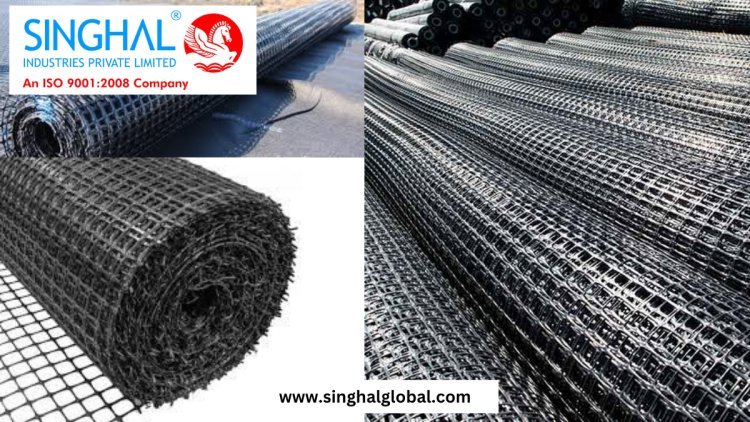The Role of Geonets in Road Construction: An Essential Geosynthetic Solution
Geonets play a vital role in road construction, offering significant advantages in drainage, stability, and cost-effectiveness. With a growing number of geonet manufacturers in India providing innovative solutions, the use of geonets as part of geosynthetic products is becoming increasingly prevalent. As infrastructure development continues to expand, understanding the benefits and applications of geonets will be essential for engineers and construction professionals looking to implement sustainable and effective practices. By integrating geonets into road construction projects, stakeholders can enhance the durability and functionality of their infrastructures while promoting environmental protection.

Geonets are a crucial component in the field of civil engineering, particularly in road construction and geotechnical applications. These innovative geosynthetic materials are designed to enhance drainage, stability, and overall performance of roadway systems. This article explores the features, benefits, and applications of geonets, focusing on Geonet geosynthetics in India, Geosynthetics products manufacturers, and Geonet manufacturers in India.
What Are Geonets?
Geonets are geosynthetic products made from interconnected polymeric strands that create a three-dimensional matrix. This structure allows for the efficient drainage of water while providing reinforcement to the soil. Typically made from high-density polyethylene (HDPE) or polypropylene, geonets are designed to serve multiple functions in various engineering applications, especially in road construction.
Key Features of Geonets
-
High Drainage Capacity: The open structure of geonets enables water to flow freely, facilitating efficient drainage in roadways, preventing water accumulation, and reducing the risk of erosion.
-
Reinforcement Properties: Geonets add strength to the soil, helping to improve the load-bearing capacity of roadways and reducing deformation under traffic loads.
-
Durability: Geonets are resistant to environmental factors such as UV radiation, chemicals, and temperature variations, ensuring a long lifespan even in harsh conditions.
-
Versatile Applications: They can be used in various applications, including subgrade reinforcement, embankments, and landfill caps.
Benefits of Using Geonets in Road Construction
1. Improved Drainage
One of the primary benefits of geonets is their ability to facilitate drainage in road construction. By allowing water to flow through the structure, geonets help prevent water accumulation, which can lead to pavement distress and other issues. Effective drainage also minimizes the risk of erosion, extending the lifespan of road infrastructure.
2. Enhanced Stability
Geonets contribute to the overall stability of road systems. By reinforcing the soil, they improve the load distribution, reducing the likelihood of settlement and deformation under traffic loads. This feature is particularly important in areas with weak or unstable soil conditions.
3. Cost-Effectiveness
Using geonets in road construction can lead to significant cost savings. By improving drainage and stability, geonets reduce the need for extensive drainage systems and maintenance. Additionally, their durability means lower replacement and repair costs over time.
4. Environmental Benefits
Geonets support environmentally friendly practices in road construction. By enhancing drainage, they help maintain natural water flow, reduce erosion, and minimize the environmental impact of construction activities.
Applications of Geonets in Road Construction
1. Subgrade Reinforcement
Geonets are commonly used in the reinforcement of subgrades, providing additional support to the soil beneath roadways. This reinforcement helps prevent settlement and extends the life of the pavement.
2. Drainage Systems
In road construction, geonets are often integrated into drainage systems to facilitate water movement away from the pavement. Their ability to quickly remove excess water helps maintain the integrity of the road surface.
3. Embankment Stabilization
Geonets can be used to stabilize embankments, providing additional support to slopes and reducing the risk of erosion. This application is particularly useful in areas prone to landslides or soil instability.
4. Landfill Cap Systems
In landfill construction, geonets serve as a drainage layer within cap systems, helping to manage leachate and maintain water flow. This application ensures that the landfill is effectively contained and minimizes environmental impact.
Choosing the Right Geonet Manufacturer in India
When searching for Geonet manufacturers in India, consider the following aspects:
-
Quality Assurance: Ensure that the manufacturer adheres to industry standards and provides high-quality geonets suitable for your specific applications.
-
Product Range: Look for manufacturers that offer a variety of geosynthetic products, allowing for flexibility in project design and implementation.
-
Reputation: Research the manufacturer’s reputation through customer reviews and testimonials. A well-established manufacturer is likely to provide reliable products and services.
-
Support Services: Consider manufacturers that offer technical support, installation guidance, and customer service to help you make informed decisions and execute your projects effectively.
Geonet Geosynthetics in India
The demand for Geonet geosynthetics in India has grown significantly in recent years due to increasing infrastructure development and a focus on sustainable construction practices. Many manufacturers are now providing high-quality geonets tailored to the unique requirements of the Indian market.
FAQs
1. What are the main materials used to manufacture geonets?
Geonets are primarily made from high-density polyethylene (HDPE) or polypropylene, which provide excellent durability, chemical resistance, and UV stability.
2. How long do geonets last?
The lifespan of geonets can vary depending on environmental conditions and application. Generally, high-quality geonets can last for several decades, particularly when properly installed and maintained.
3. Can geonets be used in areas with poor drainage?
Yes, geonets are particularly beneficial in areas with poor drainage. Their design facilitates effective water movement, helping to improve overall drainage conditions and reduce the risk of soil erosion.
What's Your Reaction?

















